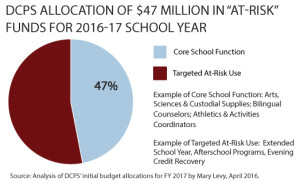When the District’s local school funding formula was changed in 2014 to add a new category for low-income students, the intent was to drive additional, targeted resources to DC’s high-poverty students. However, an analysis of the FY 2017 budget shows that nearly half of the “at-risk” funding allocated by DC Public Schools (DCPS) to individual schools is being used to support core functions which are intended to be funded for all schools and should not require dipping into supplemental at-risk funds.
 An analysis of DCPS’ FY 2017 initial school budget allocations completed by Mary Levy shows that 47 percent — or $22 million — of the school system’s at-risk resources was allocated to fund items that all schools are otherwise entitled to under DCPS’ school staffing model. For example, DCPS’s staffing model indicates that all high schools will have an attendance counselor next school year. Yet in some schools, the attendance counselor in FY 2017 will be supported using at-risk funds that should instead be used to supplement core staffing.
An analysis of DCPS’ FY 2017 initial school budget allocations completed by Mary Levy shows that 47 percent — or $22 million — of the school system’s at-risk resources was allocated to fund items that all schools are otherwise entitled to under DCPS’ school staffing model. For example, DCPS’s staffing model indicates that all high schools will have an attendance counselor next school year. Yet in some schools, the attendance counselor in FY 2017 will be supported using at-risk funds that should instead be used to supplement core staffing.
This means that nearly half of the resources considered “extra” for schools are being used for functions that are required through the DCPS staffing model applicable to all schools and should be funded accordingly. Only half of the at-risk funds will go to purposes that meet the needs of at-risk students, such as literacy initiatives or an extended school year.
These findings underscore three areas of concern and potential improvement:
- Ensuring at-risk funding supplements core functions. Next school year will be the third year of implementation for at-risk funds. While those funds follow qualifying students to their schools, it is not clear that the resources are enhancing the schools’ ability to better serve these students if a large portion is being used for core functions for which all schools get funding. DCPS should design its budget process so that at-risk funds can only add to what schools get in base funding and positions.
- School leaders need to have clear guidance and additional flexibility over the use of at-risk funds. At the same time, schools should not face any added restrictions about how to use at-risk funds, and they should not be left without adequate support for core school staff that they need. Instead, leaders need to be given enough time and guidance on how best to leverage the additional resources in meaningful ways for their students.
- Overall need for greater budget transparency. Although attempts have been made to make school budgets more transparent in recent years, the process of following how funds are allocated and what it means for schools remains difficult to track. Budget documents for individual schools should clearly identify what is funded under DCPS’s comprehensive staffing model, and what supplementary services are supported with at-risk funds.
Need more information on your DCPS school budget? Check out this interactive tool developed with support by Code for DC and the Coalition for DC Public Schools and Communities: http://dcpsbudget.ourdcschools.org. And don’t forget to sign up to testify at the DCPS budget oversight hearing on Thursday, April 14th.
Stay tuned for more education budget updates from the District’s Dime this budget season!
To print a copy of today’s blog, click here.
